$16 Million Grant Provided by Shriners Children’s Hospital
$16 Million Grant Provided by Shriners Children’s Hospital
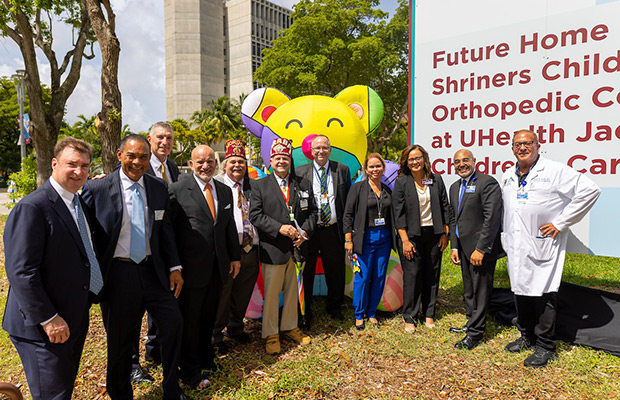
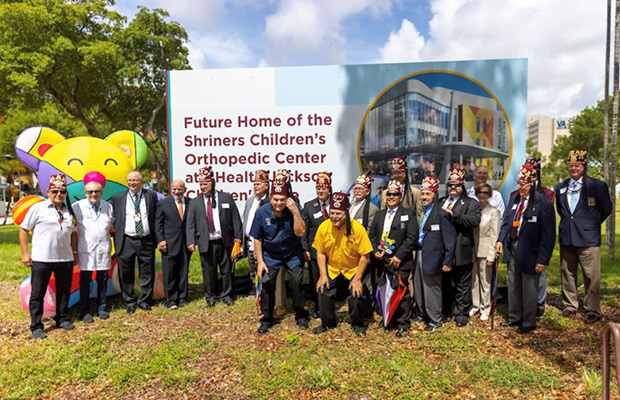
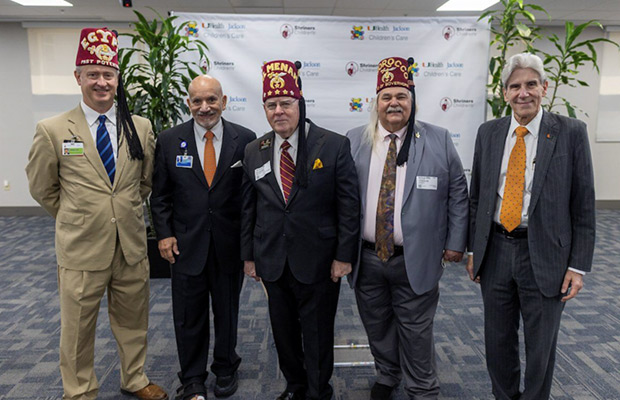
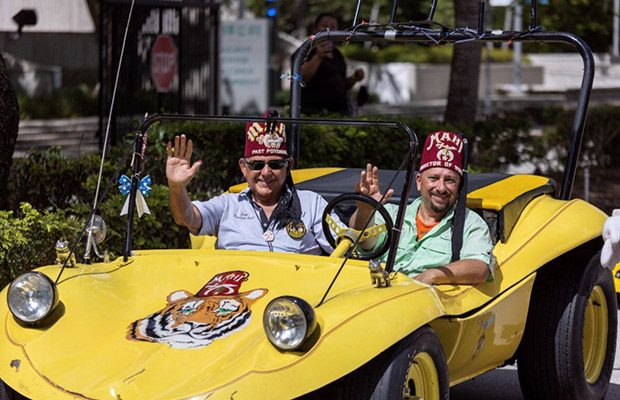
Last month, Jackson Health System, Jackson Health Foundation, UHealth – University of Miami Health System and Shriners Children’s announced a major $16 million grant to create a new regional center of excellence called Shriners Children’s Orthopedic Center at UHealth Jackson Children’s Care.
This unprecedented grant will greatly support pediatric orthopedics. Whether needs of the community come from major injuries treated in our Ryder Trauma Center or potentially debilitating conditions like cerebral palsy, spina bifida, and muscular dystrophy, the Shriners Children’s Pediatric Orthopedic Center will be a powerhouse of academic medicine.
With a signature space, new endowed chairs for pediatric orthopedics, and pediatric physical medicine and rehabilitation, this center will supply advanced world-class care for children with traumatic injuries and debilitating conditions. The enhanced orthopedic program will align with other UHealth Jackson Children’s Care signature pediatric services, including organ transplant, cardiac care, neonatology, cancer treatment, neurosurgery, and much more.
This affiliation will also be the catalyst for a new, state-of-the-art facility exclusively focused on outpatient pediatric care, which will house all ambulatory children’s services from the University of Miami/Jackson Memorial Medical Center campus under one roof – and they’ll be just steps from our pediatric emergency room, 379-bed Holtz Children’s Hospital.
Finally, this partnership will ultimately help us create the most sophisticated pediatric outpatient center in our 104-year history.
To celebrate these major announcements, we held a parade on campus, which featured a New Orleans-style jazz band, three small NASCAR race cars, and Shriners Dune Buggy Patrol cars.
South Florida Father Saved at the Miami Burn Center after Suffering Life-Threatening Burns
South Florida Father Saved at the Miami Burn Center after Suffering Life-Threatening Burns
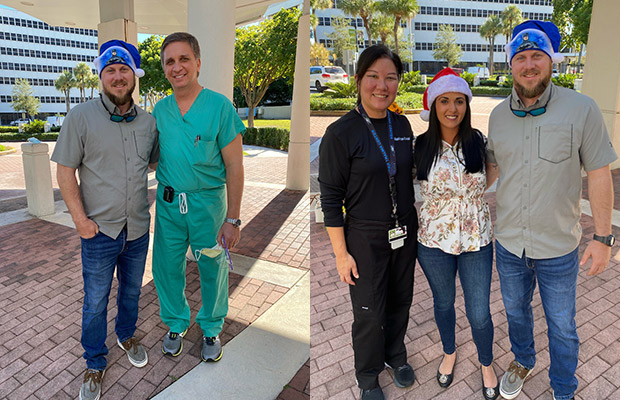
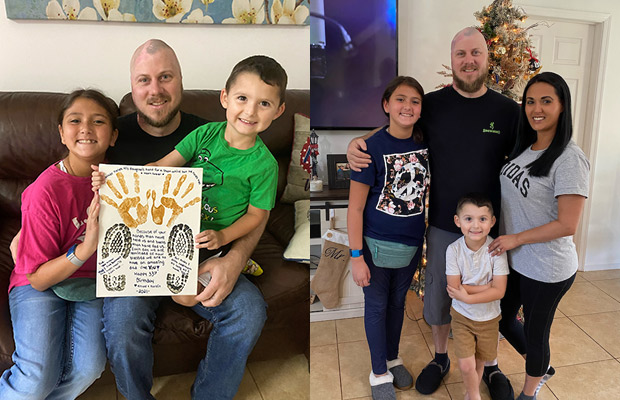
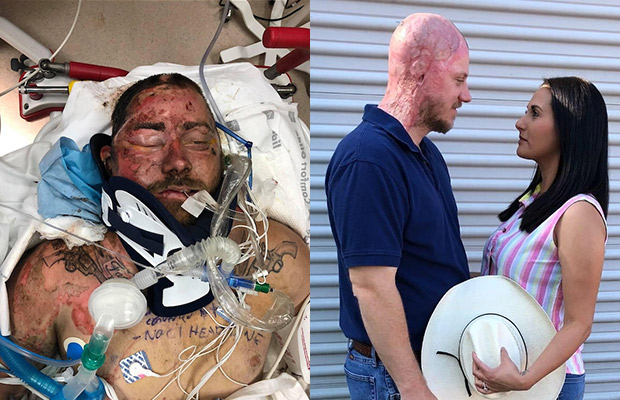
In September 2019, John Pendleton suffered life-threatening injuries at work after more than 4,000 volts of electricity entered through the top of his head and exited out of the back of his neck.
The father of two was rushed to a nearby trauma center in West Palm Beach, where he underwent an emergency tracheotomy after aspirating in his lungs. Once he was stabilized, he was airlifted to the Miami Burn Center, located inside Ryder Trauma Center at Jackson Memorial Hospital.
His medical team at the Miami Burn Center determined he had suffered a traumatic brain injury, a skull fracture, brain bleed, and third and fourth degree burns to 30 percent of his upper extremities. His organs were also shutting down. He was placed under a medically-induced coma, and remained in the burn intensive care unit for seven days.
“I was sleeping at home with our one-year-old when I received the devastating call,” said Tiffany Pendleton. “They told me my husband was taken to Ryder Trauma, and that they didn’t know the extent of his injuries other than what they could see on his scans, and that it could take some time before he could wake up.”
Pendleton, then 31, was in extreme pain, and had a long journey ahead of him.
“At that point, John’s diagnosis was very grim,” said Dr. Louis Pizano, medical director of the Miami Burn Center. “We didn’t know if he would be able to walk, talk, and live independently if he survived his severe injuries.”
Pendleton’s burns were so severe. He lost his right ear, and 40 percent of the left one. Doctors also had to extract part of the latissimus dorsi muscle – the large, flat muscle covering the width of the middle and lower back – to reconstruct his head flap, which was severely burnt in the accident.
A critical part of Pendleton’s recovery at the Miami Burn Center was intense inpatient physical, occupational, and speech therapy. Miraculously, he beat the odds, and walked out of the Miami Burn Center 60 days after his accident.
“It was a very rough time in my life, but we have remained optimistic through this entire journey,” he said. “After my injuries, my outlook on life has changed. I am so grateful, as tomorrow is not promised.”
Since his injury, Pendleton has had 10 surgeries in total, and is expected to undergo more reconstructive surgeries in the near future.
The Pendleton family is grateful to the medical team at the Miami Burn Center for all the care he received.
“Having relationships with the doctors who saved my life, participating in burn events, and bringing everyone cookies when we visit means the world to me,” said Pendleton. “Even after all the pain I’ve been through, I’m still standing here and I owe it all to them.”
Ukrainian Refugee Undergoes Procedure at Jackson Memorial Hospital to Remove Neck Mass
Ukrainian Refugee Undergoes Procedure at Jackson Memorial Hospital to Remove Neck Mass
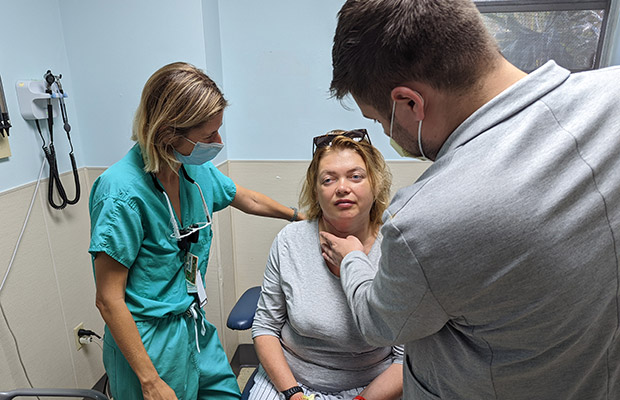
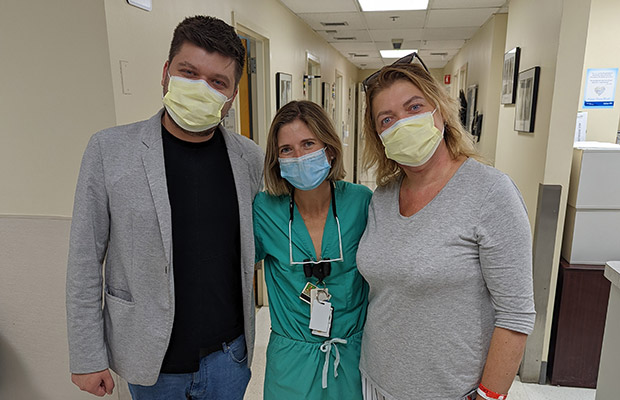
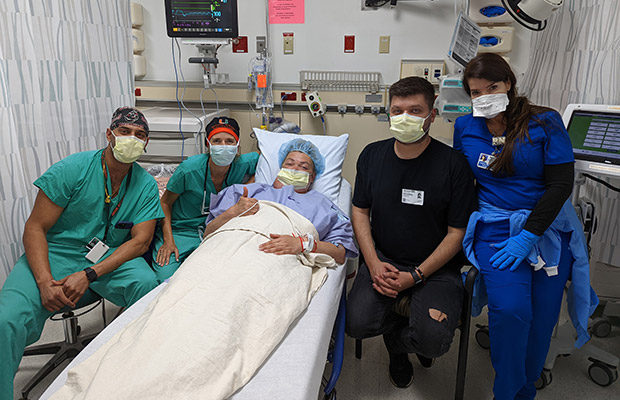
After traveling for 14 days to flee the warzone in her native Ukraine, 46-year-old Olena Orlova arrived in South Florida mid-April in the hopes of receiving treatment for a nine-centimeter cyst on her neck.
Two years ago, Ukrainian physicians discovered the mass. At the time, doctors explained the gravity of Orlova’s diagnosis, and she was advised to seek the help of a specialist. However, while searching for the care she needed, the mass continued to grow, making it difficult for Orlova to swallow and move her neck easily.
As she began to worry about the severity of her condition, she received news that a doctor was available to take on her case. Orlova was scheduled to undergo surgery on February 24. Unfortunately, all that changed the day before the procedure was supposed to take place when Russian troops invaded her hometown of Kharkiv.
“I was told in Ukraine that I only had six months to live,” Orlova recalled. “My home was destroyed; there was no access to food or health care.”
As the country faced uncertainty, Orlova became more concerned about her health. She reached out to her son Oleh Orlov to determine how she could evacuate. Orlov, who lives in Miami, began his mission to help his mother and possibly save her life.
Through the assistance of loved ones, friends, and good Samaritans, the family was able to get the financial help they needed for Orlova to begin her journey. She would travel alone through Poland, the Netherlands, Mexico, and California before her son was able to meet her in South Florida.
Thinking his mother’s life was in danger, Orlov did not want to waste time. On April 21, he took Orlova to the Emergency Department at Jackson Memorial Hospital, where she was evaluated and treated by a multidisciplinary team, including Elizabeth Nicolli, MD, a UHealth – University of Miami Health System otolaryngologist who specializes in head and neck surgery.
Orlova was diagnosed with a branchial cleft cyst – a congenital condition that occurs when tissues in the neck or collarbone fail to develop normally.
“While the mass was benign, it could continue growing and ultimately compress vital structures in her neck if left untreated,” Dr. Nicolli said. “There are important nerves and blood vessels in the neck, and our ability to speak, swallow, and breathe is centered there. We wanted to make sure to preserve and protect these areas.”
The news came as a relief for Orlova’s family, who thought her condition was life threatening.
“After what she’s been through, I felt everything was going to go well for my mom,” Orlov said. “I knew we were at one of the best hospitals, so we did not hesitate to move forward with her care.”
Upon learning of the patient’s long journey to seek help, Dr. Nicolli wanted to contribute in her own way. She advised Orlova that she would waive her physician fees to perform her surgery. Dr. Nicolli also worked with Jackson Health Foundation, Jackson Health System’s fundraising arm, to find additional support.
“This is an example of the community coming together to help someone in need,” said Flavia Llizo, the Foundation’s co-president and chief development officer. “Through the generosity of two private donors, we were fortunate to obtain the funds to pay for the additional hospital costs.”
On May 23, Orlova successfully underwent surgery at Jackson Memorial to remove her cyst.
“I am very grateful for all the support I’ve received, and to everyone who has helped me along the way,” Orlova said.
After an overnight stay at the hospital, she is now recovering well at home. She hopes to start over in South Florida and spend quality time with her son.
Man Recovers from Traumatic Brain Injury after being Hit by a Car
Man Recovers from Traumatic Brain Injury after being Hit by a Car



In May 2020, Lucas Martinez, then 21, was driving his motorcycle on Interstate 95 when he lost control of his bike and was flung onto the busy highway. Confused and unaware of what had happened, he stood up and began walking towards his motorcycle on the opposite side of the interstate. Moments after attempting to cross through traffic, Martinez was hit by a car.
He was rushed to Ryder Trauma Center at Jackson Memorial with multiple fractures to his lower extremities and a traumatic brain injury (TBI).
“I hadn’t heard from Lucas in more than 24 hours, so when two police officers knocked on my door, I braced myself for the worst,” said Christine Martinez, Lucas’ mother. “This happened near the beginning of the COVID-19 pandemic, and I couldn’t see him while he was in the hospital, which made the situation even harder.”
Martinez remained heavily sedated at Ryder Trauma for several weeks while recovering from his injuries.
He was discharged on June 10, 2020, but would require intense rehabilitation to relearn how to walk, eat, and talk.
Three months after leaving Ryder Trauma, Martinez was admitted into Christine E. Lynn Rehabilitation Center for The Miami Project to Cure Paralysis at UHealth/Jackson Memorial.
“For TBI patients, inpatient rehab is the first step of the recovery process that can continue for months or even years,” said Lauren Shapiro, MD, a UHealth – University of Miami Health System physician who specializes in traumatic brain injuries and physical medicine and rehabilitation at Lynn Rehabilitation Center.
When he arrived at Lynn Rehabilitation Center, he was only able to move his right arm, could not speak, and was receiving nutrients through a feeding tube. Over the next several weeks, Martinez would undergo intense physical, occupational, and speech therapy.
He was discharged on October 30, 2020, and was able to speak, eat solid foods, and move his left arm on his own.
“I can’t remember anything between May and October 2020,” Martinez said. “My first vivid memory was being discharged from Lynn Rehabilitation Center.”
However, he still had a long way to go in his recovery. Martinez relied on his wheelchair, family, and caretaker to help him with day-to-day tasks. He would continue receiving outpatient therapy at Lynn Rehabilitation Center.
“Those first few months of outpatient rehab were difficult,” Martinez recalled. “It was a mental and physical challenge.”
On March 24, 2021, he completed one of his first major milestones. With the help of his physical therapist, Jill Collum, he took his first steps since his accident.
In the months that followed, Martinez graduated from speech therapy, started walking with the help of a walker, and began to participate in a peer support group for TBI patients.
“When I got to Lynn Rehabilitation Center, I was shy and didn’t want to speak with other patients or my therapists,” he said. “The more I progressed in therapy, the more I broke out of my shell. Now I want to help encourage other TBI patients through their recovery.”
This newfound attitude helped Martinez overcome the difficult hurdles brought on by his injury.
“I’ve been working with Lucas for more than a year and a half. In the beginning, he wasn’t able to sit up or roll over onto his side,” Collum said. “He has been through so much in two years. He was completely dependent on his care team and family, and now he’s walking on his own.”
Today, Martinez continues to receive outpatient physical and occupational therapies. While he still has a long road to recovery ahead of him, his positive attitude and strong support from his family, friends, therapists, and doctors motivate him to keep progressing.
“My accident helped put things in perspective for me,” Martinez said. “I’ve gained a new appreciation for life, and it’s all thanks to the incredible team at Lynn Rehabilitation Center. They pushed me every day to help get me where I am today.”
South Florida Woman Receives a Heart Transplant on Daughter’s Wedding Day
South Florida Woman Receives a Heart Transplant on Daughter’s Wedding Day
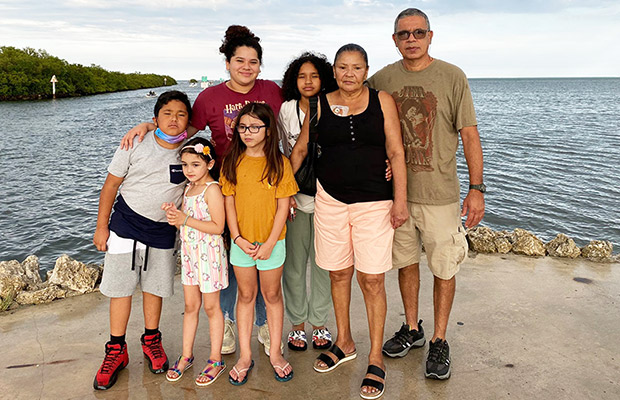
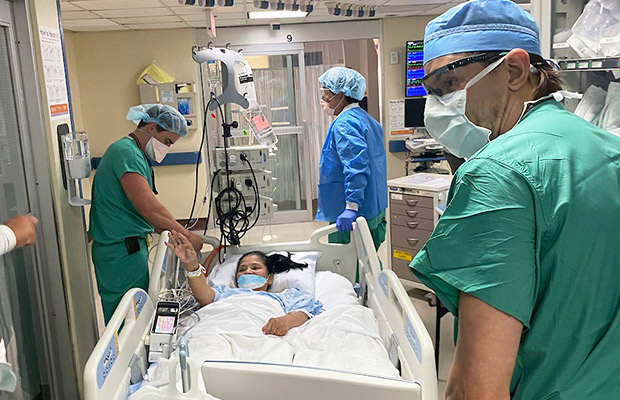
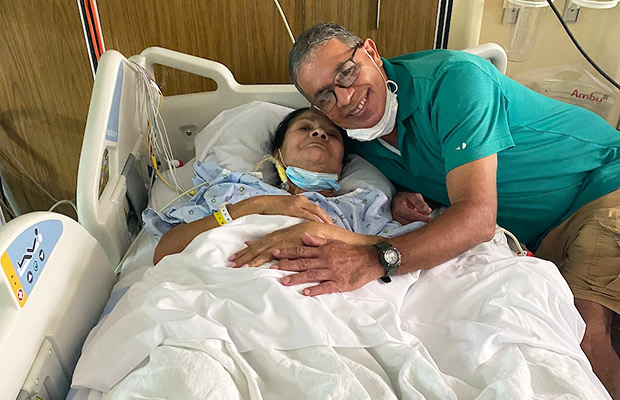
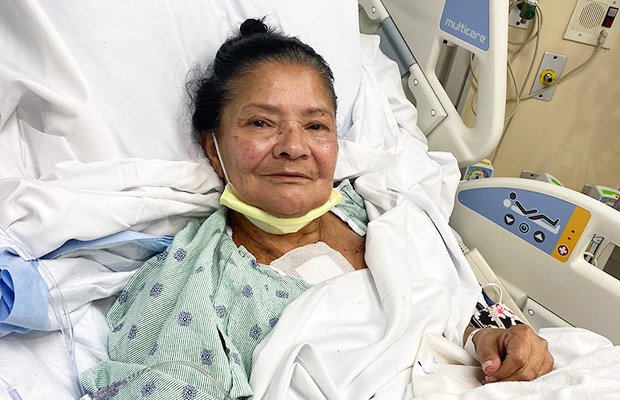
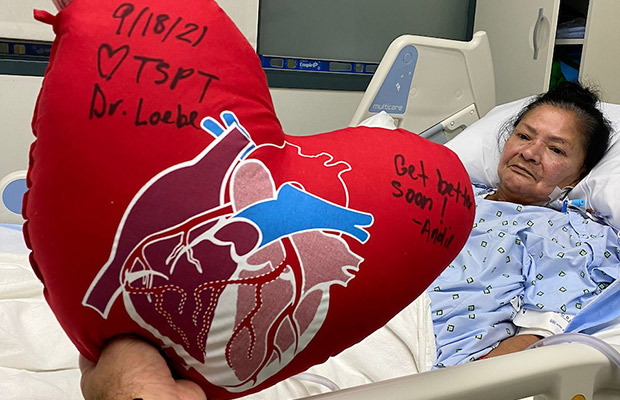
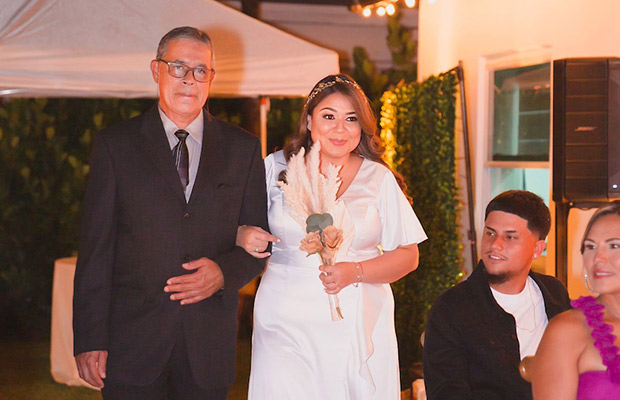
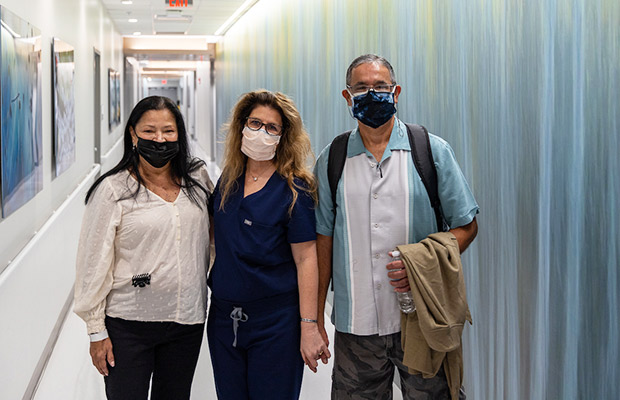
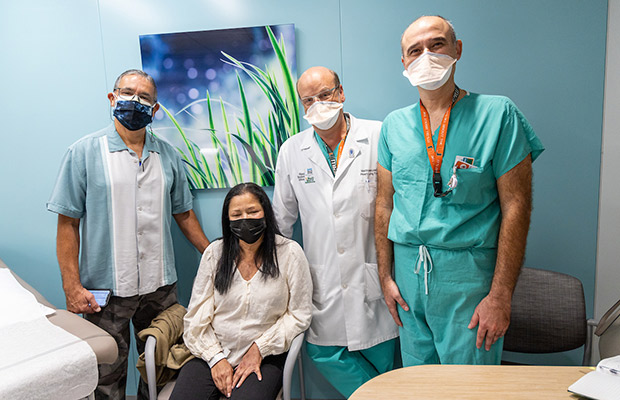
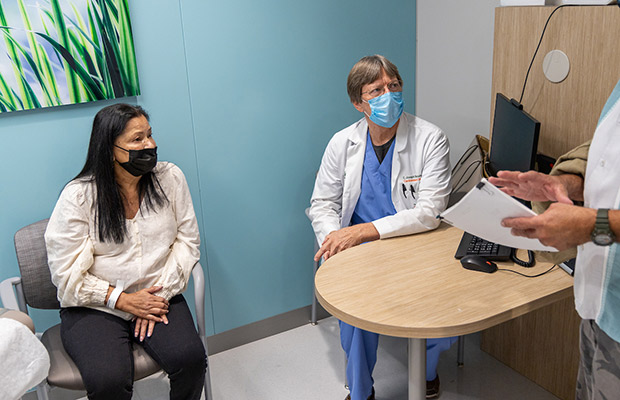
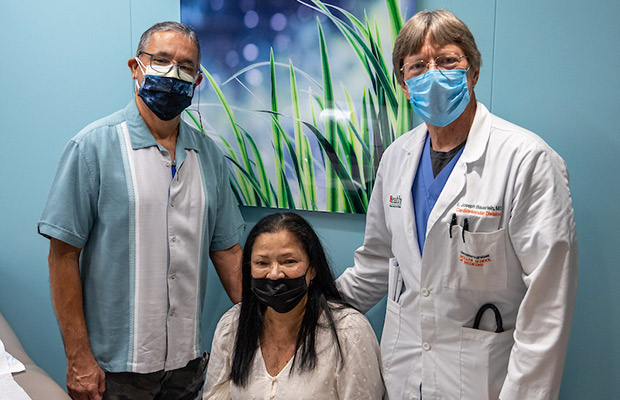
Reaching some of life’s major milestones hasn’t always seemed possible for 60-year-old Liliana Hernandez, who has been living on borrowed time for almost 20 years. As a great grandmother, grandmother, mother, and wife, she hoped for the day that her prayers would be answered.
Her husband, Alvaro Lugo, never wanted her to give up. He met Hernandez in 1976 when they were both teenagers in Cali, Colombia. Since then, they have been inseparable, moving to Miami in 1989 to start their family.
Hernandez lived a healthy life up until 2006 when she began to experience shortness of breath and fatigue. Much to the family’s dismay, she suffered a minor heart attack and was rushed to a nearby emergency room. Doctors determined that Hernandez’s heart was failing. They decided to place an implantable cardioverter-defibrillator in her body to help correct life-threatening irregular heartbeats.
Eventually, Hernandez’s defibrillator needed to be replaced. Physicians also saw that her heart’s mitral valve was not working. They tried to replace it, but the surgery was unsuccessful, leading the family to look for alternatives.
They soon sought care at the Miami Transplant Institute (MTI), an affiliation between Jackson Health System and UHealth – University of Miami Health System. In March of 2019, Hernandez was seen by UHealth cardiologist Joseph Bauerlein, MD, who diagnosed her with dilated cardiomyopathy, associated with significant valvular heart disease, which causes blockage in the coronary arteries.
“We saw that her heart function was 5 to 10 percent. We began providing Liliana with intravenous stimulant medicine to help improve her heart function while waiting for her to get stronger,” Dr. Bauerlein said. “But her only chance of long-term survival was to receive a heart transplant, so we also placed her on the national waiting list.”
Hernandez was placed on the transplant list in January of 2020.
Ten months later, she received a call that a donor was available, but unfortunately, Hernandez spiked a fever that led to a setback. During this time, the family remained calm, putting all their trust and faith in the transplant team.
Over the next year, Hernandez’s symptoms gradually got worse, and she was having a harder time breathing. In August of 2021, she returned to Jackson Memorial Hospital’s surgical intensive care unit. The team performed a catheterization procedure to monitor her heart and implanted an intra-aortic balloon pump to support her body’s blood flow.
Due to the severity of her declining health, Hernandez’s was moved up on the transplant list.
“We were scared. She was suffering, and we didn’t know what was going to happen,” Lugo said. “But our prayers were answered in September when we received the news that a heart donor was available.”
As fate would have it, Lugo was destined to give away two hearts. On September 18, 2021, the couple’s youngest daughter was getting married on the same day Hernandez was scheduled to undergo her heart transplant surgery. She wanted their daughter to continue with her wedding plans, and not to worry about her.
“I didn’t expect the transplant to happen so fast. It was overwhelming but in a good way,” Hernandez recalled. “I felt nervous but at the same time full of emotions knowing I had my family’s support.”
The surgery was performed by a multidisciplinary team led by UHealth transplant surgeon Matthias Loebe, MD, PhD, FCCP, FACC, MTI’s chief of heart and lung transplant and mechanical support. Dr. Loebe personally called Lugo to let him know that Hernandez’s surgery was a success.
“Transplant recipients and their families are under a lot of stress dealing with heartbreaking situations,” Dr. Loebe said. “It is important to me to have a close relationship with the families to guide them through this difficult process.”
The good news was received during the wedding, providing a sense of relief for Hernandez’s second chance at life.
“I have so much gratitude for my doctors and my medical team, I always felt protected,” Hernandez said. “I am not attached to machines anymore; I feel free!”
Hospital CEO Turned Patient Overcomes Stroke Diagnosis
Hospital CEO Turned Patient Overcomes Stroke Diagnosis
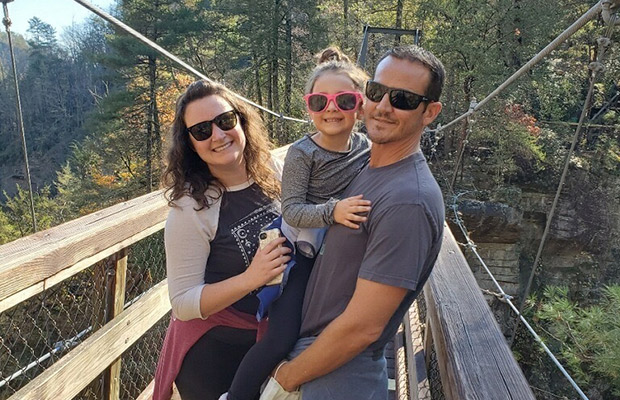

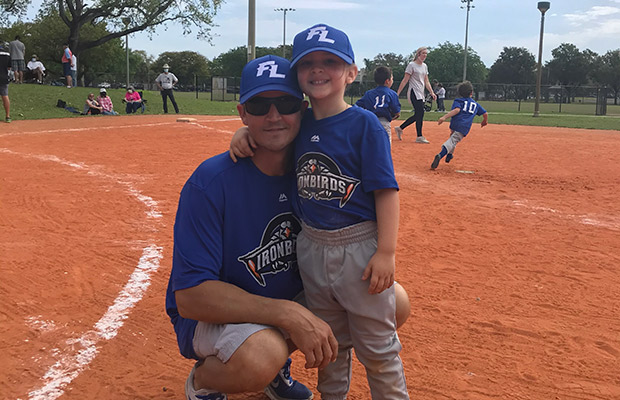
During a family vacation in July 2021, Hamilton Clark, 46, woke up in the middle of the night with a severe headache. After attempting to stand, he lost his balance and collapsed on the floor. Clark didn’t think it was serious, so once he got someone to help him up, he went back to bed.
When he returned home two days later, Clark, Jackson Memorial Hospital’s senior vice president and chief executive officer, was brushing his teeth before heading to work when he began having difficulty controlling his right hand.
At work, Clark immediately knew something was wrong when he attempted to sign his name on a document and couldn’t. Growing more concerned, he called a neurologist to his office, who did a quick examination and directed him to Jackson Memorial’s Emergency Department. It appeared that Clark was having a stroke.
“I was in disbelief,” he said. “I ate well and exercised regularly. I used to spend my weekends at the beach surfing and teaching my daughter how to play baseball and soccer. I hadn’t experienced any of the lifestyle factors that can increase your risk of having a stroke.”
In the Emergency Department, Clark was diagnosed with a cerebellum stroke that affected his right arm, right leg, balance, coordination, and ability to speak clearly.
He was transferred to Jackson Memorial’s neuro-intensive care unit (neuro-ICU), where Victor Del Brutto, MD, a UHealth – University of Miami Health System neurologist, performed CT scans and electrocardiograms to determine what might’ve caused the stroke.
“We believe his stroke may have been caused by a combination of exhaustion, dehydration, and lack of sleep,” Dr. Del Brutto said. “It isn’t very common to have a patient as fit and young as Hamilton in the neuro-ICU.”
Over the next few days, therapists from Christine E. Lynn Rehabilitation Center for The Miami Project to Cure Paralysis at UHealth/Jackson Memorial met with Clark to discuss his recovery plan.
“When I met Hamilton, I saw how determined he was to get better and how quickly he wanted to get back to full functionality,” said Kelsey Garcia, a Lynn Rehabilitation Center physical therapist.
For almost three months, Clark received three hours of physical therapy, occupational therapy, and speech therapy daily, all while performing his duties as Jackson Memorial’s CEO.
He took his physical therapy into his own hands and performed many of the exercises at home, too. Clark set up his own course, using cones and ladders to work on his agility and balance.
“When Hamilton told me he was running his own drills at home, I was shocked by how far he was pushing himself,” said Jill Collum, another Lynn Rehabilitation Center physical therapist who worked closely with Clark. “He exceeded all the expectations and goals we had set out for him.”
Clark was determined to get back to the lifestyle he used to live.
“I was told that most patients take six months to a year to recover and regain the motor skills that were affected by the stroke,” he said. “I made it my goal to recover as much as I could in three months.”
Clark completed his physical therapy in two months and regained most of the acute functions in his right arm and leg. Strengthening his speech became his next focus.
The speech-language pathology team at Lynn Rehabilitation Center incorporated Clark’s workday into his speech therapy sessions, having him give mock presentations while working on over articulating his words to strengthen the speaking muscles that were affected by his stroke.
“Being able to speak publicly is a skill that requires confidence, and I wanted to help him regain his confidence,” said Lauren Landera, one of Clark’s speech-language pathologists. “I’m proud to see how much he progressed over a span of a couple of months.”
It has been almost a year since his stroke, and Clark no longer requires any therapies. He is back to work full time and is looking forward to his surf trip in June.
“I was really humbled by my stroke,” Clark said. “I’m so grateful to the amazing teams at Jackson Memorial and Lynn Rehabilitation Center for getting me back on my feet. I owe a lot of my recovery to them and their support.”
11-year-old Boy Overcomes Brain Tumor Diagnosis
11-year-old Boy Overcomes Brain Tumor Diagnosis
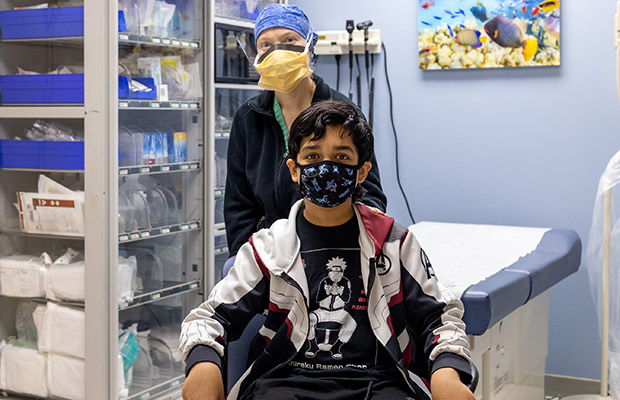
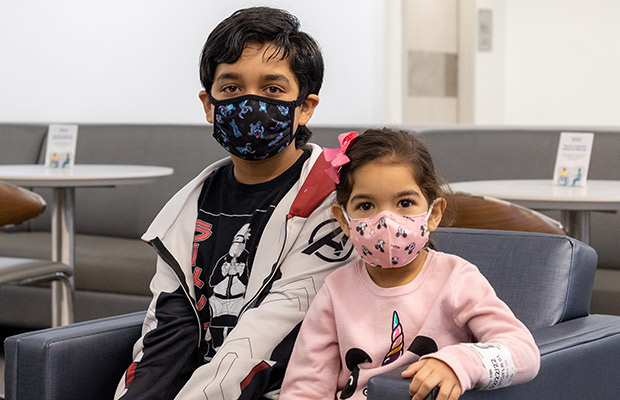
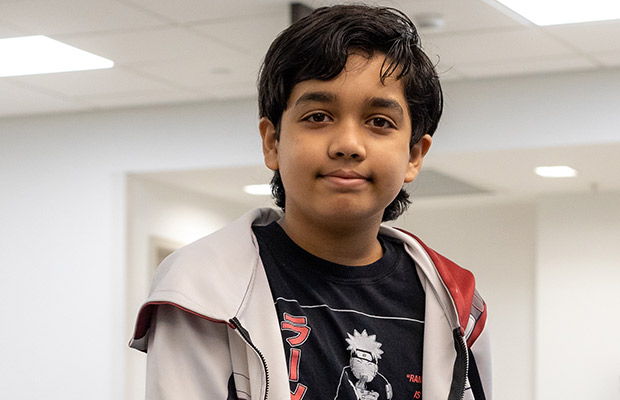
In March 2021, 11-year-old Samir Rahman started complaining of sharp pains in the back of his head whenever his parents drove over speed bumps. His mother, Shanta Reza, initially dismissed her son’s concerns.
Over time, Samir’s pain went away. During last year’s Ramadan holiday, Reza and her family began fasting, a custom in their religion. One night, after fasting for more than 12 hours, Reza remembered Samir eating much more than he normally would. Feeling dizzy and hot, he laid down in bed, where he began to vomit profusely for the next three days.
“We weren’t sure why he was vomiting,” Reza said. “He threw up so much. Everything we tried to give him, he vomited – food, water, medicine. He couldn’t keep anything down.”
Reza and her husband became concerned, and took Samir to his primary care physician. Unfortunately, his doctor could not find the cause of the problem.
Over the next few days, Reza and her husband told Samir he did not have to fast anymore, thinking the long hours without eating or drinking might have been causing him intestinal discomfort.
Nonetheless, Samir kept vomiting.
“My husband suggested taking him to the hospital after reading that vomiting might be linked to problems in the brain,” Reza said.
Reza took Samir to the pediatric emergency department at Jackson North Medical Center. Once there, he underwent a CT scan, which revealed he had a four-centimeter tumor at the base of his brain.
“When the doctors told me the news, I felt like my world had crumbled,” Reza said. “No parent is prepared to hear that their child has a brain tumor.”
The team at Jackson North referred Samir to Heather McCrea, MD, PhD, a UHealth – University of Miami Health System pediatric neurosurgeon and the director of pediatric neurosurgery at Holtz Children’s Hospital.
At Holtz Children’s, Samir received IV medication that helped control the vomiting, and underwent an MRI to confirm the brain tumor diagnosis.
“The MRI did bode well for Samir and his parents,” Dr. McCrea said. “It suggested he had a low-grade tumor that once successfully removed wouldn’t require any chemotherapy or radiation.”
Dr. McCrea informed the parents that the tumor was operable, but there were potential risks.
“We were so happy to be at Holtz Children’s and with Dr. McCrea. We knew Samir was in great hands,” Reza said. “We were cautious, though. Dr. McCrea explained to us the dangers of surgery if anything went wrong. Samir could have a stroke, a brain bleed, or a seizure.”
Last May, Samir underwent the operation. The procedure lasted six hours, and Dr. McCrea was able to remove the entire tumor successfully. Pathology results confirmed he had a juvenile pilocytic astrocytoma, a benign childhood brain tumor, and thus no additional therapies were needed.
“Samir woke up post-surgery doing great. We let him eat later that day and started mobilizing him out of bed the day after,” Dr. McCrea said. “Though I was able to get the entire tumor out, we continued to monitor him to make sure it doesn’t grow back.”
Samir remained at Holtz Children’s for a few more days, being monitored by his medical team and undergoing physical therapy sessions to ensure the surgery hadn’t negatively affected his strength, balance, or coordination.
Today, almost a year later, Samir is fully recovered and still tumor-free, with no signs of it growing back.
“There were times my husband and I looked at Samir and didn’t know if that was the last time we would ever see him,” Reza said. “Dr. McCrea is our angel. I thank God, the doctors, and the nurses at Jackson North and Holtz Children’s for saving my son’s life.”
The Perfect Match: South Florida Teacher’s Life Saved by Living Donor
The Perfect Match: South Florida Teacher’s Life Saved by Living Donor
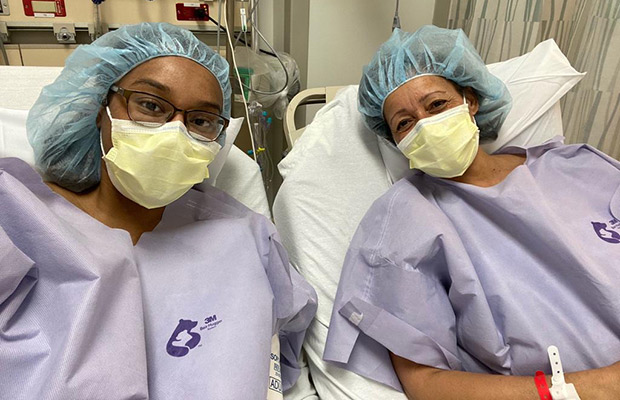
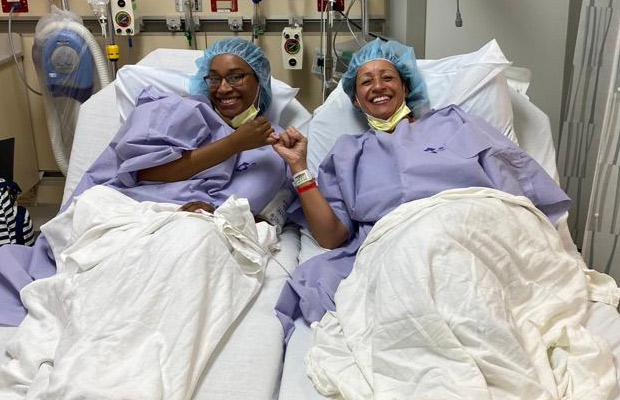
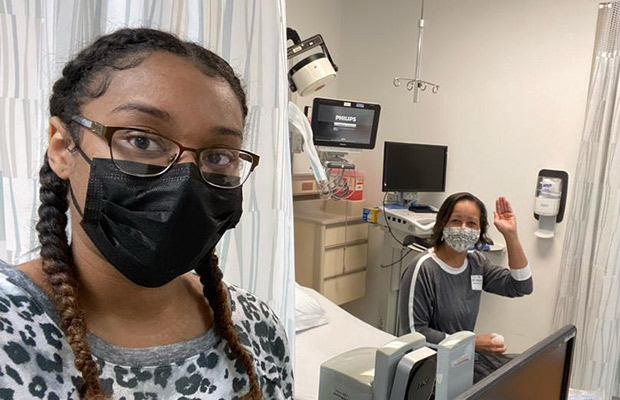
In November 2020, Tyra Starnes was shocked when her primary care doctor diagnosed her with chronic kidney disease during a routine annual exam. Up until that point, the 25-year-old West Palm Beach elementary school teacher felt healthy.
However, as her kidneys continued to deteriorate, Starnes started feeling the effects of the disease. She often felt fatigued and had developed a metallic taste in her mouth.
In April 2021, her primary care doctor referred her to Giselle Guerra, MD, medical director of transplant services and medical director of the kidney program at the Miami Transplant Institute (MTI), an affiliation between Jackson Health System and UHealth – University of Miami Health System.
Dr. Guerra took over Starnes’ treatment, immediately putting her on peritoneal dialysis, a system to remove waste from her kidneys. Shortly thereafter, Starnes and the MTI team started discussing the possibility of a kidney transplant as the best course of treatment.
“Those at risk of high blood pressure, diabetes, or who have a family history of kidney disease can develop chronic kidney disease,” Dr. Guerra explained. “Tyra had none of those things. Her disease was a result of an acute immune response that rapidly deteriorated her kidney function.”
After starting peritoneal dialysis, Starnes was placed on the national transplant list. As her condition worsened, her family came together in her support. Many of her loved ones quickly signed up to be tested as potential donors.
As fate would have it, Starnes’ great-aunt and godmother, Lesley Anderson, was a perfect match.
“When asked time and time again if I was certain I wanted to be a donor, I never questioned my answer,” Anderson said. “Tyra is my goddaughter. I was meant to be her donor. I wouldn’t have had it any other way.”
After nine months of peritoneal dialysis and follow-up appointments with the MTI team, the date for the surgery was set for January 26, 2022.
“I remember feeling drained after my last dialysis session,” Starnes recalled. “I wanted to have control over my life again. I didn’t want to wait any longer.”
On the day of the surgery, Starnes felt both worried and relieved, although she knew she was in the best hands.
A multidisciplinary team led by Rodrigo Vianna, MD, PhD, MTI’s director of transplant services and chief of liver and gastrointestinal transplant programs performed the living kidney donor transplant on Anderson using the da Vinci Surgical System. Gaetano Ciancio, MD, MTI’s chief academic and medical officer and director of the kidney and kidney-pancreas programs, transplanted Starnes.
“Robotic surgery minimizes surgical complications for living kidney donor patients. It often lessens medical risks due to shortened hospitals stays. More than 95 percent of our donors who have undergone this robotic procedure stayed in the hospital for less than 24 hours,” Dr. Vianna said. “The surgical expertise of our MTI physicians with the most complex cases, particularly when paired with innovative devices, such as the da Vinci robot, will help catapult health care to the next level for our transplant patients.”
Starnes and Anderson’s surgeries were a success, and they were both discharged on the same day. The two plan to celebrate on January 26 every year to commemorate their transplant anniversary.
“I want to let everyone know they don’t have to be afraid of becoming organ donors and should consider it,” Starnes said. “It can one day help save someone’s life.”
Patients with End-Stage Heart Failure Survive and Thrive with the LVAD Option
Patients with End-Stage Heart Failure Survive and Thrive with the LVAD Option
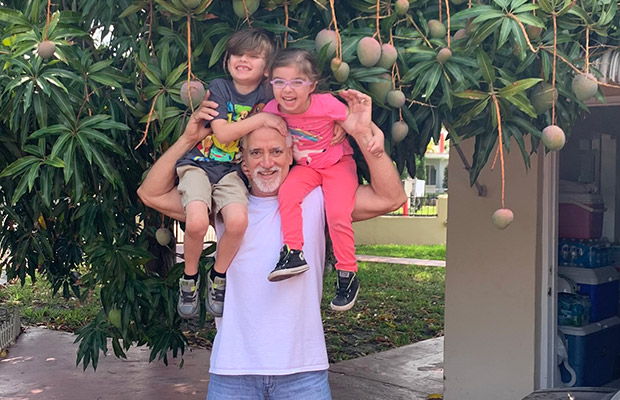
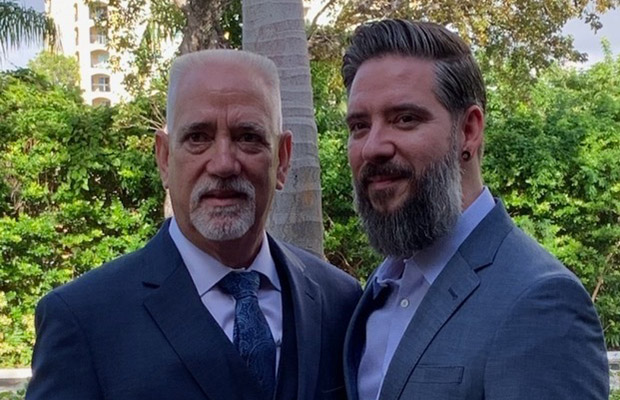
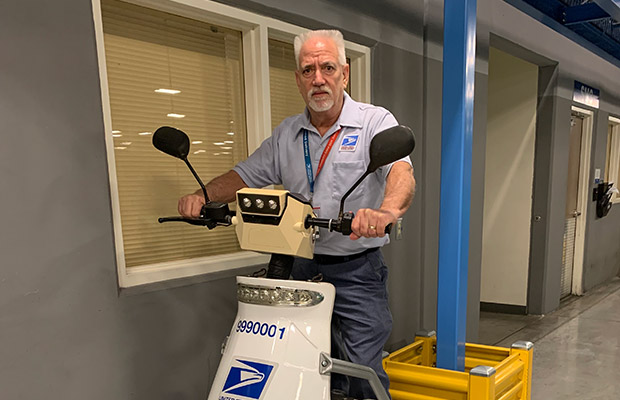
For a few months, Juan Llanes felt some discomfort in his stomach. To ease the pain, he’d drink water and feel better.
The 63-year-old postal worker never suspected his stomach issues were a sign of heart failure. Then, on January 16, 2021, he suffered a massive heart attack at home.
“Until it happened, I felt like Superman,” Llanes said.
Llanes, who never had a history of cardiac issues before his heart attack, credits his wife, Rosie Llanes, for acting quickly and dialing 911 after noticing her husband in discomfort as he was standing up from their couch.
He was rushed to a nearby hospital, where doctors inserted a stent in his coronary artery to help restore his heart’s blood flow. Unfortunately, there were serious complications.
Llanes went into multiple-organ failure and cardiogenic shock – a life-threatening condition in which the heart suddenly can’t pump enough blood to support the body’s needs. He was referred to the Miami Transplant Institute (MTI) at Jackson Memorial Hospital.
Llanes was placed into a medically induced coma for two weeks and on dialysis for two months. He was weak, and his medical team at MTI, led by Anita Phancao, MD, Chief of Heart Failure, Mechanical Circulatory Support, Transplant Cardiology at MTI, had to stabilize him if he was going to survive.
Dr. Phancao and her staff determined that Llanes’ best chance to survive was to implant in his chest a left ventricular assist device (LVAD), a battery-operated, mechanical pump that helps the lower left heart chamber pump blood to the rest of the body. The LVAD minimizes risk and offers patients enhanced quality of life.
Dr. Phancao consulted with Matthias Loebe, FACC, MD, PhD, FCCP, a leading heart transplant surgeon and Chief of Heart and Lung Transplant and Medical Support at MTI, and Llanes’ surgery was scheduled for March 10, 2021.
“This operation was the optimal option for Juan,” Dr. Loebe said. “We surgically implant the LVAD in patients who have reached end-stage heart failure and are not organ transplant candidates.”
Dr. Loebe said LVADs are a great option that help save many lives.
“The survival rate with the newest generation of LVADs is getting close to actual heart transplants,” Dr. Loebe said. “You can have an LVAD and live 10 to 12 more years.”
Llanes’ LVAD was implanted through open-heart surgery. The procedure lasted about five hours, but the length varies from patient to patient depending on their cardiac health and history.
In the hospital, a multi-disciplinary team that included nutritionists and psychologists worked with Llanes and prepared him to go home and adjust to his new lifestyle.
“What sets us apart is that we can provide the full spectrum of support,” Dr. Phancao said. “We have all the tools available to us. We prioritize educating our patients so they have a positive transition to living with an LVAD.”
Given a second chance to live, Llanes hopes to return to the workforce soon and is enjoying time with his family.
“Because of the great medical team I had at MTI, I can see my grandchildren grow up,” Llanes said. “I didn’t know about LVADs, but that procedure saved my life, and I hope this information can help save many more lives.
A Birthday Miracle: A New Heart Gives One Florida Man A Second Chance at Life
A Birthday Miracle: A New Heart Gives One Florida Man A Second Chance at Life
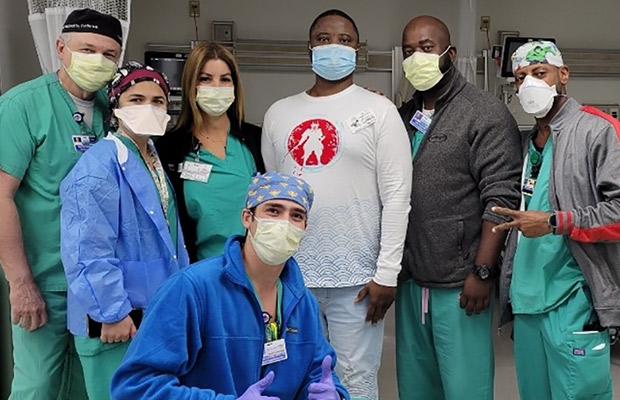
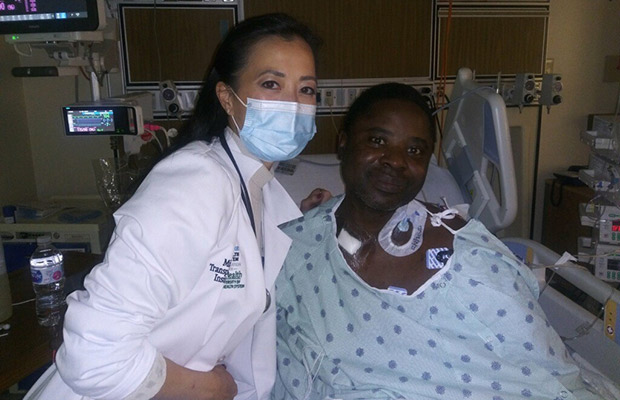
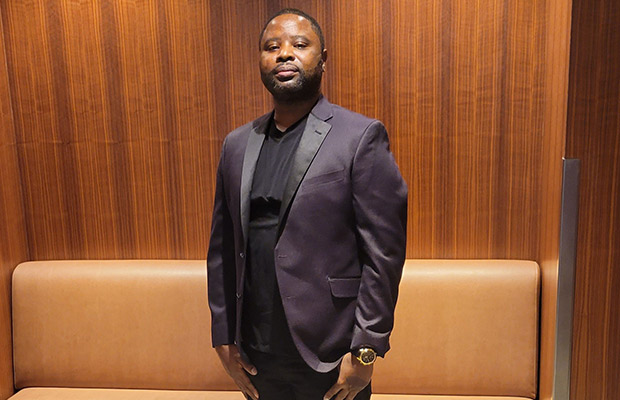
Harold Jean never knew that he was born with a heart condition. He lived a normal childhood, played sports, and exercised. But in 2005, at the age of 23, he suffered a minor stroke.
He quickly recovered, but it was the beginning of a series of health problems. Ten years later, at age 33, Jean learned his heart was weak. He was diagnosed with congestive heart failure and needed a pacemaker to help control his heartbeat.
“Even with the pacemaker, I could run and exercise,” he said. “I used to ride my bike often and was part of the Brickell Run Club.”
However, that all changed on November 23, 2020.
“I was home alone when all of a sudden, I couldn’t breathe,” he recalled.
He immediately called for a ride to Jackson Memorial Hospital.
“When I arrived at the hospital, I fainted in the emergency department,” he said. “After I woke up, I was in a hospital bed. The doctors told me if I hadn’t made it to the hospital when I did, I would’ve died.”
Anita Phancao, MD, FACC, Chief of Heart Failure, Mechanical Circulatory Support, Transplant Cardiology at the Miami Transplant Institute, was one of the doctors treating Jean.
“When Harold arrived at the hospital, he was experiencing shortness of breath, and we quickly discovered he was in cardiogenic shock, which means his heart could not pump enough blood through his body,” Dr. Phancao said. “We started him on IV medication to help support his heart and put in a balloon pump and admitted him to the intensive care unit (ICU). He was very sick, and so we put in for expedited advanced cardiac therapy, including listing him for a heart transplant.”
Due to the ongoing COVID-19 pandemic, visitors weren’t allowed in the hospital, so Jean couldn’t have his family at his bedside. Luckily, the ICU nurses caring for him stepped in. They spent time talking with him and keeping his spirits up.
“I love my nurses,” he said. “They took incredible care of me and became my family in their absence. They were so important for my mental health.”
On his birthday, the nurses that Jean had begun to call family surprised him with a cake and a birthday celebration. Then came the greatest gift of all.
“My nurse surprised me with the news that I would be receiving a new heart,” Jean said. “I was so overwhelmed with emotion and began to cry.”
On December 14, 2020 – Jean’s 40th birthday – Jean underwent a successful heart transplant.
“Despite everything going on in the world with the pandemic, our transplant team has remained steadfast and committed to performing these lifesaving procedures,” said Matthias Loebe, MD, PhD, FCCP, FACC, Chief of Heart and Lung Transplant and Mechanical Support at Miami Transplant Institute, who performed Jean’s heart transplant.
After his transplant, Jean remained hospitalized, undergoing physical therapy at the Christine E. Lynn Rehabilitation Center for The Miami Project to Cure Paralysis at UHealth/Jackson Memorial for six months as he slowly recovered and learned to walk again.
“It was a difficult challenge, but I trusted the process,” he said. “By practicing my rehab exercises each day, I was finally able to walk. Jackson is truly the best hospital in the world. They did a great job, and now I’m back to living my life.”
For Jean’s medical team, seeing him thrive is the best gift.
“Our number one goal when performing a transplant,” Dr. Loebe said, “is to help our patients get better and well enough to go back to living their life.”
Today, Jean has resumed the activities he used to enjoy, such as exercising and running. And just when he thought things couldn’t get better, Jean received a note from his organ donor’s family.
“They reached out to me first, and then I wrote them back,” Jean said. “That letter meant so much to me. As soon as I saw who it was from, I just started crying. It’s such a miracle. Someone I don’t even know saved my life.”